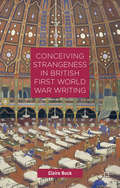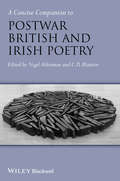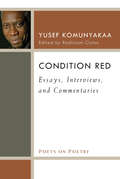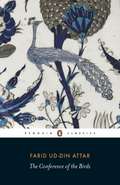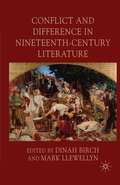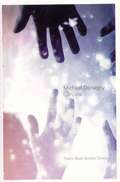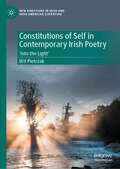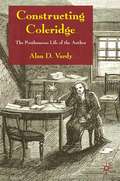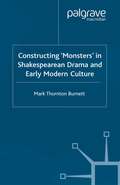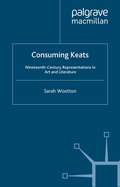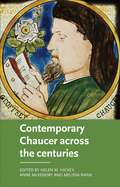- Table View
- List View
A Comprehensive Study of Tang Poetry II (China Perspectives)
by Lin GengTang poetry is one of the most valuable cultural inheritances of Chinese history. Its distinctive aesthetics, delicate language and diverse styles constitute great Literature in itself, as well as a rich topic for literary study. This two-volume set constitutes a classic analysis of Tang poetry in the “Golden Age” of Chinese poetry (618–907 CE). This volume focuses on the prominent poets and poems of Tang poetry. Beginning with an introduction to the “four greatest poets” - Li Bai, Du Fu, Wang Wei and Bai Juyi - the author discusses their subjects, language, influence, and key works. The volume also includes essays on the masterpieces of Tang poetry, categorized by topics such as love and friendship, aspirations and seclusion, as well as travelling and nostalgia. As the author stresses, Tang poetry is worth rereading because it makes our invigorates our mental wellbeing, leaving it powerful and full of vitality. This book will appeal to researchers and students of Chinese literature, especially of classical Chinese poetry. People interested in Chinese culture will also benefit from the book.
Conceiving Strangeness in British First World War Writing
by C. BuckThis book reframes British First World War literature within Britain's history as an imperial nation. Rereading canonical war writers Siegfried Sassoon and Edmund Blunden, alongside war writing by Enid Bagnold, E. M. Forster, Mulk Raj Anand, Roly Grimshaw and others, the book makes clear that the Great War was more than a European war.
The Concept of Negritude in the Poetry of Leopold Sedar Senghor
by Sylvia Washington BaNegritude has been defined by Léopold Sédar Senghor as "the sum of the cultural values of the black world as they are expressed in the life, the institutions, and the works of black men." Sylvia Washington Bâ analyzes Senghor's poetry to show how the concept of negritude infuses it at every level. A biographical sketch describes his childhood in Senegal, his distinguished academic career in France, and his election as President of Senegal.Themes of alienation and exile pervade Senghor's poetry, but it was by the opposition of his sensitivity and values to those of Europe that he was able to formulate his credo. Its key theme, and the supreme value of black African civilization, is the concept of life forces, which are not attributes or accidents of being, but the very essence of being. Life is an essentially dynamic mode of being for the black African, and it has been Senghor's achievement to communicate African intensity and vitality through his use of the nuances, subtleties, and sonorities of the French language.In the final chapter Sylvia Washington Bâ discusses the future of Senghor's belief that the black man's culture should be recognized as valid not simply as a matter of human justice, but because the values of negritude could be instrumental in the reintegration of positive values into western civilization and the reorientation of contemporary man toward life and love.Originally published in 1973.The Princeton Legacy Library uses the latest print-on-demand technology to again make available previously out-of-print books from the distinguished backlist of Princeton University Press. These editions preserve the original texts of these important books while presenting them in durable paperback and hardcover editions. The goal of the Princeton Legacy Library is to vastly increase access to the rich scholarly heritage found in the thousands of books published by Princeton University Press since its founding in 1905.
Concerning the Atlas of Scotland: And Other Poems
by Tom PowTom Pow spent six months as writer in residence at the National Library of Scotland Map Library in Edinburgh. He was so inspired by the collection that they hold and by the stories that they tell that he wrote a collection of poetry based on that experience. Published by Polygon but with input from the National Library and illustrated with details from the collection, this beautiful and quite haunting collection will be welcomed by map lovers as well as poetry lovers.
A Concise Companion to Postwar British and Irish Poetry (Concise Companions to Literature and Culture #31)
by Nigel Alderman C. D. BlantonThis volume introduces students to the most important figures, movements and trends in post-war British and Irish poetry. An historical overview and critical introduction to the poetry published in Britain and Ireland over the last half-century Introduces students to figures including Philip Larkin, Ted Hughes, Seamus Heaney, and Andrew Motion Takes an integrative approach, emphasizing the complex negotiations between the British and Irish poetic traditions, and pulling together competing tendencies and positions Written by critics from Britain, Ireland, and the United States Includes suggestions for further reading and a chronology, detailing the most important writers, volumes and events
A Concise Companion to Postwar British and Irish Poetry (Concise Companions to Literature and Culture #31)
by Nigel Alderman C. D. BlantonThis volume introduces students to the most important figures, movements and trends in post-war British and Irish poetry. An historical overview and critical introduction to the poetry published in Britain and Ireland over the last half-century Introduces students to figures including Philip Larkin, Ted Hughes, Seamus Heaney, and Andrew Motion Takes an integrative approach, emphasizing the complex negotiations between the British and Irish poetic traditions, and pulling together competing tendencies and positions Written by critics from Britain, Ireland, and the United States Includes suggestions for further reading and a chronology, detailing the most important writers, volumes and events
A concordance to the rhymes of The Faerie Queene (The Manchester Spenser)
by J. B. LethbridgeThis book is the first ever concordance to the rhymes of Spenser’s epic. It gives the reader unparalleled access to the formal nuts and bolts of this massive poem: the rhymes which he used to structure its intricate stanzas. As well as the main concordance to the rhymes, the volume features a wealth of ancillary materials, which will be of value to both professional Spenserians and students, including distribution lists and an alphabetical listing of all the words in The Faerie Queene. The volume breaks new ground by including two studies by Richard Danson Brown and J. B. Lethbridge, so that the reader is given provocative analyses alongside the raw data about Spenser as a rhymer. Brown considers the reception of rhyme, theoretical models and how Spenser’s rhymes may be reading for meaning. Lethbridge in contrast discusses the formulaic and rhetorical character of the rhymes.
El conde Lucanor
by Juan Manuel Infante De CastillaAsí, el conde Lucanor, un caballero noble , honrado y respetable va a pedir consejo a su fiel Patronio, para resolver diferentes situaciones. El conde recibirá siempre de su subordinado una historia semejante a la planteada, y le permitirá al conde una reflexión, una moraleja, una sentencia ejemplarizante en versos. Quedarán como una especie de legado para los demás hombres de buen talante y servirá para que no caigan en similares yerros. Estructurado en una multitud de ejemplos, aflorarán temas como la envidia, los celos, la lucha por el honor y la honradez, la consecución de la perfección del alma para acceder a Dios. El lector se verá reflejado en los casos, que no pierden actualidad.
Condition Red: Essays, Interviews, and Commentaries (Poets On Poetry)
by Yusef KomunyakaaCondition Red collects writing by one of America’s most gifted and revered poets, Yusef Komunyakaa. While themes from his earlier prose collection, Blue Notes, run through Condition Red, this volume expresses a greater sense of urgency about the human condition and the role of the artist. Condition Red includes his powerful letter to Poetry magazine, asserting that “we writers (artists) cannot forget that we are responsible for what we conjure and embrace through language, whether in essays, novels, plays, poems, or songs.” Also included are essays and interviews on: coming home to Bogalusa, Louisiana; the influence of religion on black poetry; language and eroticism; the visual artist Floyd Tunson; and the poets Robert Hayden, Walt Whitman, Clarence Major, and Etheridge Knight. The book features an extended introduction by editor Radiclani Clytus, who concludes that “Condition Red issues readers much more than a critical warning; it reminds us that our innate cultural capacity for language is, and always has been, the sum total of that which defines us.”
The Conference of the Birds: The Selected Sufi Poetry Of Farid Ud-din Attar (Ways Of Mysticism Ser. #Vol. 1)
by Farid AttarComposed in the twelfth century in north-eastern Iran, Attar's great mystical poem is among the most significant of all works of Persian literature. A marvellous, allegorical rendering of the Islamic doctrine of Sufism - an esoteric system concerned with the search for truth through God - it describes the consequences of the conference of the birds of the world when they meet to begin the search for their ideal king, the Simorgh bird. On hearing that to find him they must undertake an arduous journey, the birds soon express their reservations to their leader, the hoopoe. With eloquence and insight, however, the hoopoe calms their fears, using a series of riddling parables to provide guidance in the search for spiritual truth. By turns witty and profound, The Conference of the Birds transforms deep belief into magnificent poetry.
Confession and Memory in Early Modern English Literature: Penitential Remains (Early Modern Literature in History)
by Paul D. Stegner TeichmannThis is the first study to consider the relationship between private confessional rituals and memory across a range of early modern writers, including Edmund Spenser, Christopher Marlowe, William Shakespeare, and Robert Southwell.
Confessional Poetry in the Cold War: The Poetics of Doublespeak (American Literature Readings in the 21st Century)
by Adam BeardsworthThis book explores how confessional poets in the 1950s and 1960s US responded to a Cold War political climate that used the threat of nuclear disaster and communist infiltration as affective tools for the management of public life. In an era that witnessed the state-sanctioned repression of civil liberties, poets such as Robert Lowell, John Berryman, Sylvia Plath, Anne Sexton, and Randall Jarrell adopted what has often been considered a politically benign confessional style. Although confessional writers have been criticized for emphasizing private turmoil in an era of public crisis, examining their work in relation to the political and affective environment of the Cold War US demonstrates their unique ability to express dissent while averting surveillance. For these poets, writing the fear and anxiety of life in the bomb’s shadow was a form of poetic doublespeak that critiqued the impact of an affective Cold War politics without naming names.
Conflict and Difference in Nineteenth-Century Literature
by D. Birch M. LlewellynHow should we understand Victorian conflict? The Victorians were divided between multiple views of the political, religious and social issues that motivated their changing aspirations. Such debates are a fundamental aspect of the literature of the period and these essays propose new ways of understanding their significance.
Congratulations, Rhododendrons
by Mary GermaineIn her debut collection, Congratulations, Rhododendrons, award-winning poet Mary Germaine offers love poems to an insistently unlovely world.Through poems that speak to plastic bags and drones as much as they admire roses and the moon, Germaine surfs the confluence of artificial and natural environments, technology, and our small but consequential feelings about them. At turns devotional and suspicious, these poems toe the boundaries of intimacy, responsibility, and reason.In anxious times, anything can be taken as a sign; a crow, a talking coin, and a news report are all sources of information whose truth (or “fake-ness”) demand investigation. Germaine’s poems scroll from a shrine in Lourdes to an augmented-reality sandbox, from a mall filled with loitering ex–love interests to a fairy-tale ending where all the men turn out to be chairs. Funny, provocative, sly, and melancholic, Congratulations, Rhododendrons makes a case for the hope that every apparent disaster of social investment might in the end be redeemed as meaningful, genuine, or at least in some way helpful.
Conjure
by Michael DonaghyConjure is Michael Donaghy’s third collection, and his most accomplished to date, displaying the same trademark elegance, sleight of hand and philosophical wit that have established his reputation as a ‘poet’s poet’. But while these poems time their feints and punches as well as ever, often the poet’s guard is deliberately kept down: Conjure’s elegies and disappearing acts, love songs and tortuous journeys represent the most challenging, vulnerable and moving work Donaghy has yet written. ‘Among the finest American poets of his generation’ Robert McPhillips ‘The artistry of Donaghy’s work seems to me exemplary’ Sean O’Brien ‘The fine-tuned precision of a twelve-speed bike’ Alfred Corn
The Connected Condition: Romanticism and the Dream of Communication (Stanford Text Technologies)
by Yohei IgarashiThe Romantic poet's intense yearning to share thoughts and feelings often finds expression in a style that thwarts a connection with readers. Yohei Igarashi addresses this paradox by reimagining Romantic poetry as a response to the beginnings of the information age. Data collection, rampant connectivity, and efficient communication became powerful social norms during this period. The Connected Condition argues that poets responded to these developments by probing the underlying fantasy: the perfect transfer of thoughts, feelings, and information, along with media that might make such communication possible. This book radically reframes major poets and canonical poems. Igarashi considers Samuel Taylor Coleridge as a stenographer, William Wordsworth as a bureaucrat, Percy Shelley amid social networks, and John Keats in relation to telegraphy, revealing a shared attraction and skepticism toward the dream of communication. Bringing to bear a singular combination of media studies, the history of communication, sociology, rhetoric, and literary history, The Connected Condition proposes new accounts of literary difficulty and Romanticism. Above all, this book shows that the Romantic poets have much to teach us about living with the connected condition and the fortunes of literature in it.
Constitutions of Self in Contemporary Irish Poetry: ‘Into the Light’ (New Directions in Irish and Irish American Literature)
by Wit PietrzakConstitutions of Self in Contemporary Irish Poetry explores the figure of the lyrical self in the work of six contemporary Irish poets: Paul Muldoon, Vona Groarke, Sinéad Morrissey, Caitríona O’Reilly, Alan Gillis and Nick Laird. By focusing on the self, this study offers the first sustained exploration of what is arguably one of the most distinctive features of Irish poetry. Readings utilise the latest theories of the lyric filtered through the work of such philosophers as Jacques Derrida, Umberto Eco, Slavoj Žižek, Giorgio Agamben and Zygmunt Bauman, and connect an interdisciplinary approach with attention to the operations of the poetic text to bring out aspects of the self in Irish writing that have been given only cursory critical attention so far.
Constructing Coleridge: The Posthumous Life of the Author
by A. VardyConstructing Coleridge examines Coleridge's penchant for re-invention and carefully demonstrates how the Coleridge family editors followed his lead in constructing his posthumous reputation. Following his death in 1834, the family editors faced immediate scandals and sought to construct the Coleridge they preferred in these trying circumstances.
Constructing Monsters in Shakespeare's Drama and Early Modern Culture (Early Modern Literature in History)
by Mark Thornton BurnettConstructing 'Monsters' in Shakespearean Drama and Early Modern Culture argues for the crucial place of the 'monster' in the early modern imagination. Burnett traces the metaphorical significance of 'monstrous' forms across a range of early modern exhibition spaces - fairground displays, 'cabinets of curiosity' and court entertainments - to contend that the 'monster' finds its most intriguing manifestation in the investments and practices of contemporary theatre. The study's new readings of Shakespeare, Marlowe and Jonson make a powerful case for the drama's contribution to debates about the 'extraordinary body'.
Consuming Keats: Nineteenth-Century Representations in Art and Literature
by S. WoottonThis book explores the impact of Keats on authors and artists from 1821 to the end of the First World War. It examines the work of authors including Shelley, Browning and Thomas Hall Caine, and artists Holman Hunt and Rossetti. The study also includes tributes to Keats by women authors and artists such as Christina Rossetti and Jessie Marion King.
Containing Multitudes: Walt Whitman and the British Literary Tradition
by Gary SchmidgallWalt Whitman burst onto the literary stage raring for a fight with his transatlantic forebears. With the unmetered and unrhymed long lines of Leaves of Grass, he blithely forsook "the old models" declaring that "poems distilled from other poems will probably pass away." In a self-authored but unsigned review of the inaugural 1855 edition, Whitman boasted that its influence-free author "makes no allusions to books or writers; their spirits do not seem to have touched him." There was more than a hint here of a party-crasher's bravado or a new-comer's anxiety about being perceived as derivative. But the giants of British literature were too well established in America to be toppled by Whitman's patronizing "that wonderful little island," he called England-or his frequent assertions that Old World literature was non grata on American soil. As Gary Schmidgall demonstrates, the American bard's manuscripts, letters, prose criticism, and private conversations all reveal that Whitman's negotiation with the literary "big fellows" across the Atlantic was much more nuanced and contradictory than might be supposed. His hostile posture also changed over the decades as the gymnastic rebel transformed into Good Gray Poet, though even late in life he could still crow that his masterwork Leaves of Grass "is an iconoclasm, it starts out to shatter the idols of porcelain." Containing Multitudes explores Whitman's often uneasy embrace of five members of the British literary pantheon: Shakespeare, Milton, Burns, Blake, and Wordsworth (five others are treated more briefly: Scott, Carlyle, Tennyson, Wilde, and Swinburne). It also considers how the arcs of their creative careers are often similar to the arc of Whitman's own fifty years of poem-making. Finally, it seeks to illuminate the sometimes striking affinities between the views of these authors and Whitman on human nature and society. Though he was loath to admit it, these authors anticipated much that we now see as quintessentially Whitmanic.
The Contemplative Poetry of Gerard Manley Hopkins
by Maria R. LichtmannIn 1989, the centenary of his death, Gerard Manley Hopkins continues to provoke fundamental questions among scholars: what major poetic strategy informs his work and how did his reflections on the nature of poetry affect his writing? While form meant a great deal to Hopkins, it was never mere form. Maria Lichtmann demonstrates that the poet, a student of Scripture all his life, adopted Scripture's predominant form--parallelism--as his own major poetic strategy. Hopkins saw that parallelism struck deep into the heart and soul, tapping into unconscious rhythms and bringing about a healing response that he identified as contemplation. Parallelism was to him the perfect statement of the integrity of outward form and inner meaning.Other critics have seen the parallelism in Hopkins's poems only on the auditory level of alliterations and assonances. Lichtmann, however, builds on the views held by Hopkins himself, who spoke of a parallelism of words and of thought engendered by the parallelism of sound. She distinguishes the integrating Parmenidean parallelisms of resemblance from the disintegrating Heraclitean parallelisms of antithesis. The tension between Parmenidean unity and Heraclitean variety is resolved only in the wordless communion of contemplation. This emphasis on contemplation offers a corrective to the overly emphasized Ignatian interpretation of Hopkins's poetry as meditative poetry. The book also makes clear that Hopkins's preference for contemplation sharply differentiates him from his Romantic predecessors as well as from the structuralists who now claim him.Originally published in 1989.The Princeton Legacy Library uses the latest print-on-demand technology to again make available previously out-of-print books from the distinguished backlist of Princeton University Press. These editions preserve the original texts of these important books while presenting them in durable paperback and hardcover editions. The goal of the Princeton Legacy Library is to vastly increase access to the rich scholarly heritage found in the thousands of books published by Princeton University Press since its founding in 1905.
Contemporary Chaucer across the centuries (Manchester Medieval Literature and Culture)
by Helen M. Hickey Anne McKendry Melissa RaineThis unique and exciting collection, inspired by the scholarship of literary critic Stephanie Trigg, offers cutting-edge responses to the writings of Geoffrey Chaucer for the current critical moment. The chapters are linked by the organic and naturally occurring affinities that emerge from Trigg's ongoing legacy; containing diverse methodological approaches and themes, they engage with Chaucer through ecocriticism, medieval literary and historical criticism, and medievalism. The contributors, trailblazing international specialists in their respective fields, honour Trigg's distinctive and energetic mode of enquiry (the symptomatic long history) and intellectual contribution to the humanities. At the same time, their approaches exemplify shifting trends in Chaucer scholarship. Like Chaucer's pilgrims, these scholars speak to and alongside each other, but their essays are also attentive to 'hearing Chaucer speak' then, now and in the future.

